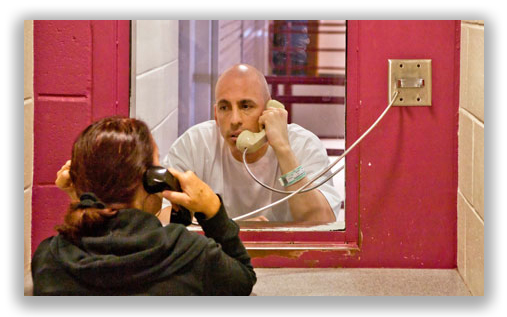We post news and comment on federal criminal justice issues, focused primarily on trial and post-conviction matters, legislative initiatives, and sentencing issues.

JAIL-STYLE VISITS ARE BETTER THAN NO VISITS AT ALL
The Bureau of Prisons announced last week that visitation at federal prisons will resume by October 3rd, but that all visits will be county jail-style: non-contact, and social distancing between inmates and visitors will be enforced with plexiglass or similar barriers, or physical distancing. Inmates in quarantine or isolation will not allowed visits.
 The BOP plan will permit every inmate up to two visits a month. Visitors will be symptom-screened and temperature-checked, and both inmate and visitor must wear masks. Tables, chairs and other “high-touch” surfaces will be cleaned following the completion of visiting each day, the BOP said.
The BOP plan will permit every inmate up to two visits a month. Visitors will be symptom-screened and temperature-checked, and both inmate and visitor must wear masks. Tables, chairs and other “high-touch” surfaces will be cleaned following the completion of visiting each day, the BOP said.
Kevin Ring, president of FAMM, said the BOP’s action represents a “first step” for anxious families who have gone months without seeing loved ones. But he said the proposed restrictions, particularly the prohibition on physical contact, will be “difficult.”
Leaders of BOP employees’ unions think the visits will be difficult, too, but for different reasons. They question the timing of the decision, inasmuch as it’s being instituted just as flu season begins and – experts predict – the coronavirus pandemic may worsen again. Some suggest the BOP is opening “Pandora’s box.”
In order to ensure inmates all get at least two visits per month, visitation days could occur seven days per week, according to Aaron McGlothin, the union leader for employees at FCI Mendota, California. That means more risks for exposure for staff, he said.
 “I’m seeing a lot of anger,” said Joe Rojas, the Southeast regional vice president for the national prison union. “We’re coming to the flu season, there’s still a pandemic and then they’re putting up visiting.” Rojas said he knew visitation was important to inmates, and he does not want to remain closed to visits. But “this is important for keeping them safe,” he said.
“I’m seeing a lot of anger,” said Joe Rojas, the Southeast regional vice president for the national prison union. “We’re coming to the flu season, there’s still a pandemic and then they’re putting up visiting.” Rojas said he knew visitation was important to inmates, and he does not want to remain closed to visits. But “this is important for keeping them safe,” he said.
McGlothin said the BOP should try other methods first, such as allowing inmates to use Zoom or Skype to video chat.
At the same time, questions are now being asked about the longer-term psychological effects of pandemic restrictions on prisoners. Elizabeth Kelley, an attorney and author who has written two books on mental illness and prison, told Forbes magazine that she is concerned that prolonged lack of visitation, along with other COVID-19 limitations, may contribute to a spate of mental illnesses among inmates. “Someone who does not have diagnosable mental illness before going to prison,” Kelley said, “may very well develop one during the pandemic because of profound anxiety, depression and later PTSD caused by the trauma associated with the COVID-19 conditions in federal prison.”
BOP Press Release, Bureau to Resume Social Visitation (September 1, 2020)
USA Today, Federal prisons resume visitation in October, 7 months after COVID-19 forced suspension (September 1, 2020)
Impact 2020, Federal prisons are lifting COVID-19 visitor restrictions — and workers are worried (September 3, 2020)
Forbes, Mental Fatigue, Anxiety and Hopelessness, Welcome to Today’s American Federal Prison Experience (August 28, 2020)
– Thomas L. Root

